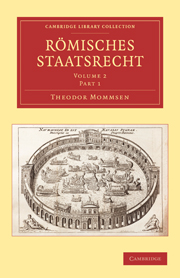Book contents
- Frontmatter
- Contents
- Das Königthum S. 3—15
- Die magistratische Befugniss des Oberpontifex S. 16—69
- Das Consulat S. 70—124
- Die Dictatur S. 125—153
- Das Reiterführeramt S. 156—164
- Der Consulartribunat S. 165—175
- Die Prätur S. 176—216
- Die Provinzialstatthalterschaft S. 217—246
- Der Volkstribunat S. 247—303
- Die Censur S. 304—442
- Die Aedilität S. 443—491
- Die Quästur S. 492—538
- Magistratische Offiziere S. 539—545
- Die magistratische Geschwornenleitung S. 546—555
- Der Vigintisex-, später Vigintivirat S. 556—571
- Ausserordentliche Beamte für die Reservatrechte der Gemeinde S. 572—600
- Ausserordentliche Aushülfsbeamte S. 601—637
- Die Senatsboten (legati) S. 638—661
- Die ausserordentlichen constituirenden Gewalten S. 662—697
Die magistratische Geschwornenleitung S. 546—555
Published online by Cambridge University Press: 29 August 2010
- Frontmatter
- Contents
- Das Königthum S. 3—15
- Die magistratische Befugniss des Oberpontifex S. 16—69
- Das Consulat S. 70—124
- Die Dictatur S. 125—153
- Das Reiterführeramt S. 156—164
- Der Consulartribunat S. 165—175
- Die Prätur S. 176—216
- Die Provinzialstatthalterschaft S. 217—246
- Der Volkstribunat S. 247—303
- Die Censur S. 304—442
- Die Aedilität S. 443—491
- Die Quästur S. 492—538
- Magistratische Offiziere S. 539—545
- Die magistratische Geschwornenleitung S. 546—555
- Der Vigintisex-, später Vigintivirat S. 556—571
- Ausserordentliche Beamte für die Reservatrechte der Gemeinde S. 572—600
- Ausserordentliche Aushülfsbeamte S. 601—637
- Die Senatsboten (legati) S. 638—661
- Die ausserordentlichen constituirenden Gewalten S. 662—697
Summary
Von einer besonderen Leitung der von dem Magistrat niedergesetzten Geschworenen weiss der ältere römische Prozess nichts. Bei der ältesten Gestalt des Civilprozesses, dem Verfahren vor Einzelgeschwornen (index unus), kann von Leitung überall keine Rede sein. Auch in dem gleichfalls sehr alten recuperatorischen kennen wir keine Einrichtung, wonach einer derselben als Vormann fungirt hätte; wie denn auch bei der mässigen regelmässig die von drei oder fünf) nicht übersteigenden Zahl der gemeinschaftlich urtheilenden Recuperatoren ein besonderes Bedürfniss dafür nicht eintreten konnte. — Insofern die Rathmanner (consilium), welche sowohl der Einzelgeschworne im Civilprozess wie der in Criminalfällen richtende Magistrat zuziehen konnte und der Sitte nach zuziehen musste, ihren Rath in Form einer Urtheilsfällung ertheilten, kam derjenige, dem die Urtheilsfallung oblag, allerdings in die Lage des Gerichtsvorsitzers und Leiters); indess so lange dieser Rath das blieb, was der Name besagt, lässt sich auch dies nicht im formellen Sinn als Geschwornenleitung auffassen.
Eine neue Form) des Prozesses entstand im J. 605 d. St. zunächst für die Civilklage, die den Unterthanen Roms gegen gewesene Beamte wegen Erpressungen zustand. In derselben floss das Griminalverfahren des mit Zuziehung eines Consiliurn untersuchenden Magistrats mit dem civilrechtlichen Recuperatorenprozess gewissermassen zusammen: der Magistrat (lbernahm die Gerichtsleitung, das Consilium die Urtheilsfindung und beide gemeinschaftlich erledigten den Prozess.
- Type
- Chapter
- Information
- Römisches Staatsrecht , pp. 546 - 555Publisher: Cambridge University PressPrint publication year: 2010



